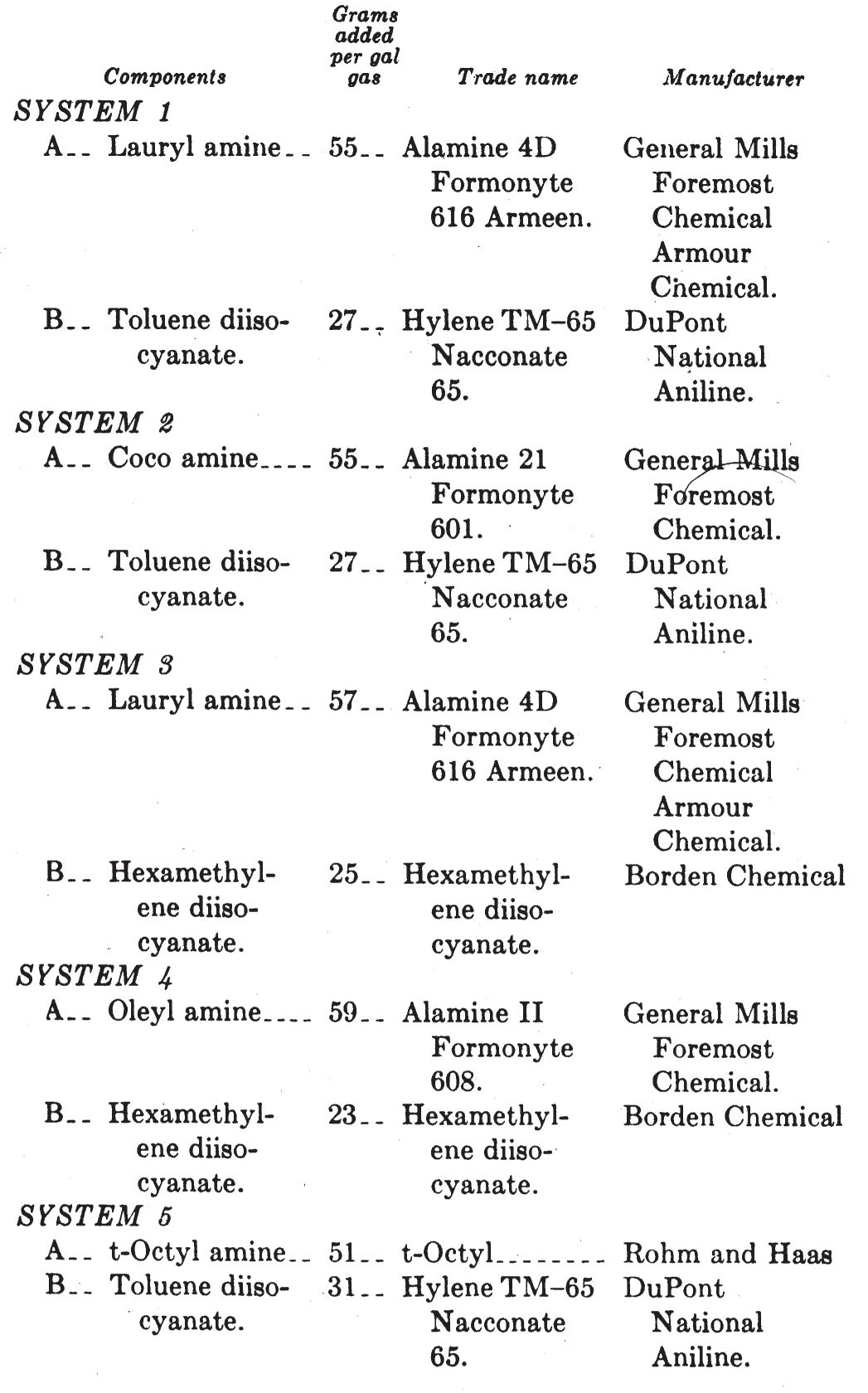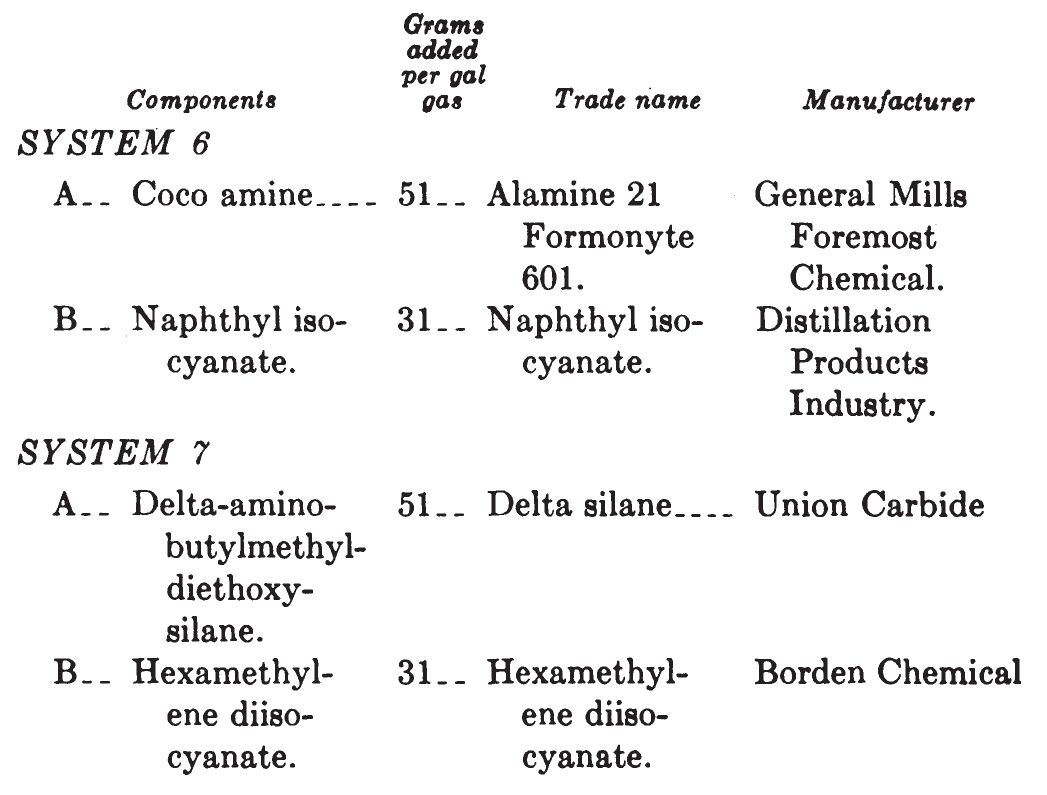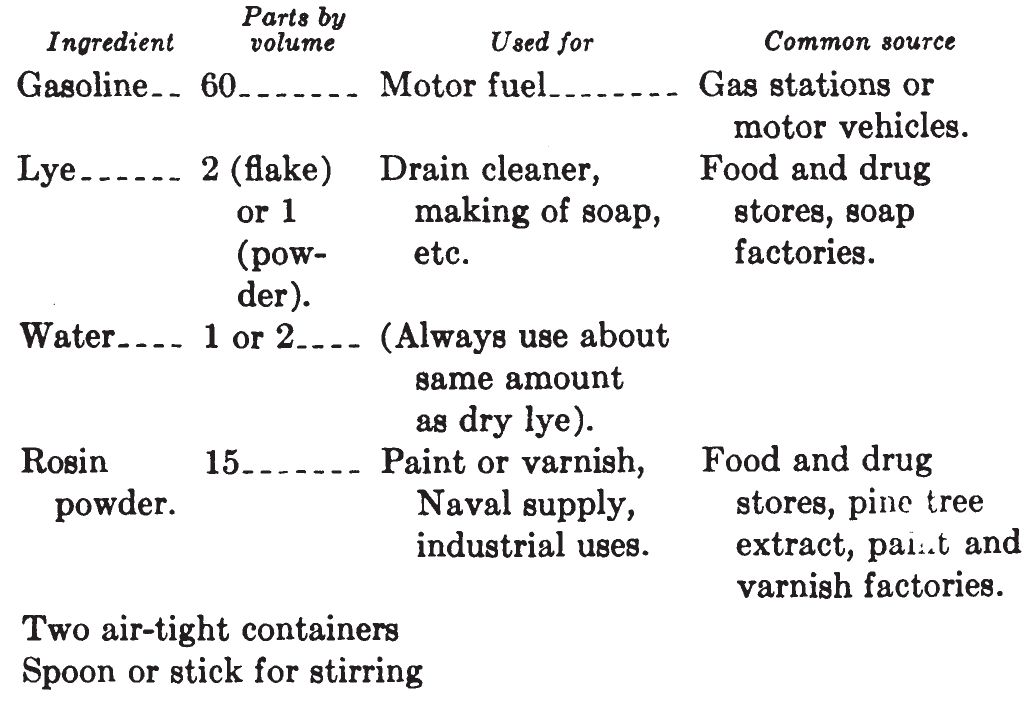Read U.S. Army Special Forces Guide to Unconventional Warfare Online
Authors: Department of the Army
U.S. Army Special Forces Guide to Unconventional Warfare (5 page)

a. Description.
- This item consists of a mixture of finely powdered magnesium and finely powdered barium peroxide. It can be used to ignite all the incendiaries listed in chapter 4 and is particularly suited for ignition of thermite. It may be used directly as an incendiary on readily flammable material such as rags, dry paper, dry hay, or in the combustible vapor above liquid fuels.
- The igniter can be initiated by Fuse Cord (0101) or Improvised String Fuse (0102).
b. Material and Equipment.
Magnesium powder (no coarser than table salt).
Barium peroxide (no coarser than table salt).
Spoon.
Container with tight-fitting lid.
c. Preparation.
- Using a clean, dry spoon, place powdered magnesium into the dry mixing container to one-quarter container volume.
- Wipe the spoon with a clean, dry cloth, then add powdered barium peroxide to the dry mixing container to three-quarters container volume. Tighten the lid on the barium peroxide container, and remove it at least six feet from the working area.
- Tightly close the lid on the mixing container. Turn the container on its side and slowly roll until the two powders are completely mixed. The mixture is now ready for use.
- A good practice is to keep the powdered magnesium and powdered barium peroxide in separate containers and mix just before use.
d. Application.
- Carefully pour or spoon the mixture, in a single pile, onto the incendiary. Prepare the mixture for ignition with Fuse Cord (0101) or Improvised String Fuse (0102) in the normal manner. The fuse cord should terminate near the center of the igniter mixture.
- In ignition of thermite, spread the igniter mixture to a depth of at least
 inch on the top surface of the thermite which is held in an assembly described under
inch on the top surface of the thermite which is held in an assembly described under
Application
of Thermite incendiary (0307). The fuse cord will initiate the thermite igniter which will, in turn, ignite the thermite. - When used to ignite flammable liquids, wrap a quantity of the mixture in a nonabsorbent material and suspend it inside the container near the open top. The container must remain open for easy ignition and combustion of the flammable liquid.
- To minimize the hazard of premature ignition of flammable liquid vapors, allow at least two feet of fuse length to extend from the top edge of an open container of flammable liquid before lighting the fuse.
a. Description
.
- This item consists of a mixture of a metal powder and an oxidizing agent. Two metal powder alternates and four oxidizing agent alternates are specified. In the combustion process, the metal powder is oxidized, resulting in the liberation of a large quantity of heat.
- This subigniter is a substitute for Magnesium Powder Barium Peroxide Igniter (0210), and should be used only if that Igniter is not available. The disadvantage of this subigniter is that it cannot be directly initiated by fuse cord. To use this subigniter for initiating thermite, it is necessary to use another igniter mixture to initiate the subigniter, preferably Sugar-Chlorate (0201). The fuse cord will initiate the sugar-chlorate, which will, in turn, ignite the subigniter and, thereby, initiate the thermite.
- This subigniter can be directly initiated by all the igniters listed in chapter 3 except White Phosphorus (0209).
b. Material and Equipment.
Either aluminum or magnesium filings or powder (no coarser than granulated sugar).
Any one of the following oxidizing agents: sodium dichromate, potassium permanganate, potassium nitrate, or potassium dichromate (no coarser than granulated sugar).
Container with tight-fitting lid.
c. Preparation.
- Using a clean, dry spoon, place one of the metal powders or filings in the container to one-third container volume. If metal filings are used, they should be free of grease.
- Wipe the spoon with a clean, dry cloth and add an equal quantity of one of the above oxidizing agents.
- Tighten the lid on the mixing container, turn the container on its side and slowly roll until the two powders are completely mixed. The mixture is now ready to use and may be stored for months in this tightly sealed container.
d. Application.
- To use this subigniter, spread the material to a depth of at least ¼ inch on the top surface of the thermite which is held in an assembly described under
Application
of Thermite Incendiary (0307). Spread another igniter, preferably Sugar-Chlorate (0201) on top of this subigniter to about the same depth. Prepare the mixture for ignition with Fuse Cord (0101) or Improvised String Fuse (0102) in the normal manner. The fuse cord should terminate near the center of the igniter mixture. The fuse cord initiates the sugar-chlorate igniter which ignites the thermite subigniter which then ignites the thermite. - For delay times longer than those conveniently obtained with fuse cord in ignition of thermite by this subigniter method, refer to chapter 5.
Caution:
Never attempt to ignite thermite subigniter without at least a few seconds delay fuse. It burns extremely fast and hot, and the user could be seriously burned if he were too close when ignition occurred.
INCENDIARY MATERIALS
a. Description.
- This item consists of a liquid fuel which is gelled by the addition of soap powder or soap chips. It is easily prepared from readily available materials.
- This incendiary can be directly initiated by a match flame. However, if delay is required, the incendiary can be reliably initiated by a delay system consisting of any igniter listed in chapter 3 coupled with a delay mechanisms found in chapter 5.
- Napalm incendiary is easily ignited and long burning, and is suitable for setting fire to large wooden structures and other large combustible targets: It adheres to objects, even on vertical surfaces.
b. Material and Equipment.
Soap powder or chips (bar soap can be easily shaved or chipped). Detergents
cannot
be used.
Any of the following liquid hydrocarbon fuels: gasoline, fuel oil, diesel oil, kerosene, turpentine, benzol or benzene, toloul or toluene.
A double boiler made from any material with the upper pot having a capacity of at least two quarts.
A spoon or stick for stirring.
A source of heat such as a stove or hot plate.
A knife or grater if only bar soap is available.
An air-tight container.
c
Preparation.
- Fill bottom of double boiler with water and heat until the water boils. Shut off source of heat.
- Place upper pot on top of bottom pot and remove both containers to a point several feel from the heat source.
- Pour soap chips or powder into the upper pot of the double boiler to one-quarter of pot volume.
- Pour any one of the liquid hydrocarbon fuels listed under
Material and Equipment
above into the upper pot containing the soap chips or powder until the pot is one-half full.Caution
: Keep these fuels away from open flames. - Stir the mixture with a stick or spoon until it thickens to a paste having the consistency of jam. Do this in a well ventilated room where the vapors will not concentrate and burn or explode from a flame or spark.
- If the mixture has not thickened enough after about 15 minutes of stirring, remove the upper pot and put it several feet from the heat source. Again bring the water in the lower pot to a boil. Shut off heat source, place upper pot in lower pot at a location several feet from the heat source and repeat stirring until the napalm reaches the recommended consistency.
- When the proper consistency is obtained, store the finished napalm in a tightly sealed container until used. Napalm will keep for months when stored this way.
d. Application.
- To use napalm most effectively, it should be spread out over the surface of the material to be burned. This will start a large area burning at once. A match can be used to directly initiate this incendiary. A short time delay in ignition can be obtained by combining Fuse Cord (0101) or Improvised String Fuse (0102) and one of the igniter mixtures found in chapter 3. (For example, several spoonfuls of Sugar-Chlorate mixture (0201) are placed in a nonabsorbent wrapping material. Fuse cord is buried in the center of the igniter mixture and the fuse is taped to the wrapping material. This assembly is placed directly on the napalm. Delay times are determined by the length of fuse. Suitable delay mechanisms are given in chapter 5 for delay times longer than those practical with fuse cord.)
- Napalm made with the more volatile fuels should not ordinarily be used with a delay longer than one hour because the liquid fuel evaporates and this can reduce its effectiveness. In very hot weather, or if the napalm is exposed to the direct rays of the sun, it is recommended that napalm be made with fuel oil. In extremely cold weather, it is recommended that napalm be made with gasoline.
- The destructive effect of napalm is increased when charcoal is added. The charcoal will readily ignite and the persistent fire from the charcoal will outlast the burning napalm. It is recommended that at least one quart of napalm be used to ignite heavy wooden structures and large wooden sections. A minimum of one-half quart is recommended for wooden structures of small cross section.
a. Description.
- This item consists of gasoline which is gelled with small quantities of organic chemicals. The operation is carried out quickly, without heat, by addition of the chemicals while stirring.
- This incendiary can be directly initiated by a match flame. However, any igniter listed in chapter 3 can be used in conjunction with specific delay mechanisms found in chapter 5 for delayed ignition of this incendiary.
- Gelled gasoline incendiary is readily ignited, long burning, and is suitable for setting fire to large wooden structures and other large combustible targets. It adheres to objects, even on vertical surfaces.
b. Material and Equipment.
Gasoline.
Balance or scale.
Spoon or stick for stirring.
Large air-tight container.
Small jar.
One of the following seven additive systems:


c. Preparation.
- Determine the amount of gasoline to be gelled and place this amount in the large container.
Caution:
Keep this material away from open flames. - Weigh out the appropriate quantity of component A. This can be calculated by multiplying the number of gallons of gasoline by the figure given in the
Grams Added Per Gal
. Gas. column of systems. (For example, if System 1 is being used and five gallons of gasoline are being gelled, then (5Ã55) or 275 grams of Lauryl amine are required). - Add component A to the gasoline and stir for a few minutes to dissolve.
Caution:
Both components A and B are corrosive to the skin. If any of these materials contact the skin, wash the area with detergent and water. - Clean the small container used to weight component A thoroughly or use another container for weighing component B. Weigh out the proper quantity of component B. Calculate the proper amount as mentioned above for component A.
- Stir the gasolineâcomponent A mixture rapidly and add all of component B at once, not a little at a time. At the same time that component B enters the mixture, remove the stirring rod and allow a few minutes for the gelling to take place.
- Store the gelled gasoline in a tightly sealed container until ready to use. It will keep for months when stored in this manner.
d. Application.
- To use gelled gasoline most effectively, it should be spread out over the surface of the material to be burned. This will start a large area burning at once. A match can be used to directly initiate this incendiary. A short time delay in ignition can be obtained by combining Fuse Cord (0101), or Improvised String Fuse (0102) and one of the igniter mixtures found in chapter 3. (For example, several spoonfuls of Sugar-Chlorate mixture (0201) are placed in a nonabsorbent wrapping material. Fuse cord is buried in the center of the igniter mixture and the fuse is taped to the wrapping material. This assembly is placed directly on the gelled gasoline. Delay times are determined by the length of fuse. Suitable delay mechanisms are given in chapter 5 for delay times longer than those practical with fuse cord.)
- Gelled gasoline should not ordinarily be used with a delay longer than one hour because gasoline evaporates and this can reduce its effectiveness.
- The destructive effect of gelled gasoline is increased when charcoal is added. The charcoal will readily ignite and the persistent fire from the charcoal will outlast the burning gasoline. It is recommended that at least one quart of gelled gasoline be used to ignite heavy wooden structures and large wooden sections. A minimum of one-half quart is recommended for wooden structures of small cross section.
Note
. All of the chemicals used for the gelling process
must
be added in a
liquid
state. Many of the chemicals solidify at near freezing temperatures (32° F.) and uniform gels are difficult to produce at these temperatures.
- This item consists of gasoline which is gelled by the addition of certain ingredients that are locally available. The following eight basic systems will produce gelled gasoline and are easily prepared: Lye systems, Lye-alcohol systems, Lye-balsam systems, Soap-alcohol systems, Egg system, Latex system, Wax systems, and Animal blood systems. These systems are discussed in the subparagraphs under 0303.
- These incendiaries can be directly initiated by a match flame. However, any igniter listed in chapter 3 can be used in conjunction with specific delay mechanisms given in chapter 5 for delayed ignition.
- Gelled gasoline incendiary is readily ignited, long burning and is suitable for setting fire to large wooden structures and other large combustible targets. It adheres to objects, even on vertical surfaces.
b. Material and Equipment.

Note.
Lye is also known as caustic soda or sodium hydroxide. Allow for strength of lye; if only 50% (as in Drano), use twice the amount indicated above. Castor oil can be substituted for the rosin. Potassium hydroxide (caustic potash, potassa) may be used in place of lye.
c. Preparation.
- Measure the required quantity of gasoline and place in a clean container.
Caution:
Keep material away from open flames. - Break the rosin into
small
pieces and add to the gasoline. - Stir the mixture for about five minutes to disperse the rosin.
- In a separate container dissolve the lye in water.
Caution:
Add lye to water slowly. Do not prepare this solution in an aluminum container. - Add this solution to the gasoline mixture and stir until mixture thickens (about one minute).
- The mixture will thicken to a very firm butter paste within one to two days. The mixture can be thinned, if desired, by mixing in additional gasoline. Store in an air-tight container until ready to use.
d. Alternate Preparation Using Pyrethrum Extract Instead of Rosin.
- Replace rosin by the following:

- Measure 78 parts by volume of gasoline and place in a clean container.
Caution:
Keep material away from open flames. - Dissolve the pyrethrum extract in the gasoline by stirring.
- In another container dissolve the lye in water.
Caution:
Add lye to water slowly. Do not prepare this solution in an aluminum container. - Add 4 parts by volume of the lye solution to the gasoline mixture.
- Stir every 15 minutes until gel forms. Store in an air-tight container until ready to use.
e. Application
- To use gelled gasoline most effectively, it should be spread out over the surface of the material to be burned. This will start a large area burning at once. A match can be used to directly initiate this incendiary. A short time delay in ignition can be obtained by combining Fuse Cord (0101) or Improvised String Fuse (0102) and one of the igniter mixtures found in chapter 3. (For example, several spoonfuls of Sugar-Chlorate Mixture (0201) are placed in a nonabsorbent wrapping material. Fuse cord is buried in the center of the igniter mixture and the fuse is taped to the wrapping material. This assembly is placed directly on the gelled gasoline. Delay times are determined by the length of fuse. Suitable delay mechanisms are given in chapter 5 for delay times longer than those practical with fuse cord.)
- Gelled gasoline should not ordinarily be used with a delay longer than one hour because gasoline evaporates and this can reduce its effectiveness.
- The destructive effect of gelled gasoline is increased when charcoal is added. The charcoal will readily ignite and the persistent fire from the charcoal will outlast the burning gasoline. It is recommended that at least one quart of gelled gasoline be used to ignite heavy wooden structures and large wooden sections. A minimum of one-half quart is recommended for wooden structures of small cross section.
